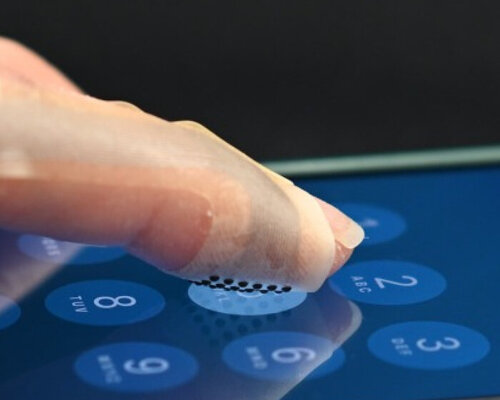Engineers create stretchable bandage device, VoxeLite
Engineers at Northwestern University have created VoxeLite, a stretchable bandage-like device around the fingertip to let users ‘feel the digital world.’ Comprising a series of nodes, the wrap helps create ‘digital touch’ that replicates the way a human fingertip senses real-life touch. This means the device makes signals that match the natural signals our skin detects, which the research team describes as ‘human resolution.’ Because of this, users can ‘feel’ the clothes when they shop online or the maps when they use the navigation app. VoxeLite is a thin sheet made from latex, and inside this sheet is a grid of small nodes. Each node is separate and can move on its own.
The sheet can bend and wrap around a fingertip, held on the finger in the same way a bandage stays on the skin. Each node works like a pixel of touch and is made of three parts: a soft rubber dome, a conductive outer layer, and an inner electrode. When voltage is applied to the node, electroadhesion happens, which is essentially the same effect that lets a balloon stick to a wall after rubbing it. With the stretchable bandage-like device VoxeLite, the electroadhesion lets each node ‘grip’ a surface and then tilt or move, and it presses lightly into the skin, letting users feel what’s happening in the digital world by mimicking it.
all images courtesy of Northwestern University
Northwestern University team tests gadget replicating touch
The stretchable bandage-like device VoxeLite is thin and stretchable, so the nodes sit very close together. In the version tested in experiments by the researchers, the distance between nodes was about 1.6 millimeters, while in another version, documented in their study, the nodes were 1 millimeter apart. This spacing is important because the fingertip can only detect separate points if they are not too close or too far apart.
The device works in two modes. In active mode, the device creates virtual tactile patterns, so when the user moves a finger over a smooth surface, each node changes friction through voltage (higher voltage increases friction while lower voltage decreases it) and can press into the skin. The device can activate nodes very quickly, replicating the way human touch feels.
the wrap helps create ‘digital touch’ that replicates the way a human fingertip senses real-life touch
Users can feel surfaces in online shopping and tactile maps
In passive mode, the wrap produces no virtual signals, but the user can still feel real surfaces under the sheet because the stretchable bandage-like device VoxeLite isn’t blocking natural touch. The main idea of the project is to solve the spatial and temporal resolution in the digital touch. Spatial resolution means how many separate touch points the device can place on the skin at the same time, while temporal means how fast the device can turn the touch points on and off.
Many past haptic devices could solve one of these problems, but VoxeLite is designed to work on both. The engineers plan future versions that can connect to smartphones or tablets, which can let users feel surfaces in online shopping, use tactile maps, or feel objects in games. The research team plans to continue running tests to study how people sense these signals and make them feel the digital world using wearable technology.
engineers at Northwestern University have created VoxeLite, a stretchable bandage device around the finger
the device makes signals that match the natural signals our skin detects
VoxeLite is a thin sheet made from latex, and inside this sheet is a grid of small nodes
when voltage is applied to the node, electroadhesion happens
the electroadhesion lets each node ‘grip’ a surface and then tilt or move
project info:
name: Toward human-resolution haptics: A high-bandwidth, high-density, wearable tactile display
institution: Northwestern University | @northwesternu
researchers: Sylvia Tan, Michael A. Peskhin, Roberta L. Klatzky, J. Edward Colgate
study: here
The post wearable bandage device around finger lets users feel the digital world appeared first on designboom | architecture & design magazine.

